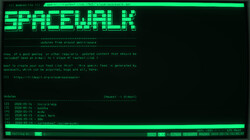Gemini Articles of Interest
A Gemini client* is needed for the following links.
-
Gemini is not decentralized
Many people say that Gemini is decentralized. But it's not like that! Yes, Gemini is handsome and graceful. But after all, as in https, gemini is organized on the same technological principles.
And here you can also be banned for your thoughts and beliefs, and sometimes just because you are a citizen of some country. I had such a case when my capsule was banned. Other than that, I'm not the only one.
-
If Gemini is a bicycle, the web is a bus
Maybe there could be a more integrated and user-friendly app? I vaguely remember the “blogging apps” from the early 00s. Maybe it could do both editing and transfer?
-
A seven-line summary of Gemini’s markup format
All line breaks count for real, which is great for poetry but means that when you write long paragraphs, you need to put all of the paragraph on one line.
That’s all. There is no way to mark text as italic or bold.
-
Linux NILFS file system: automatic continuous snapshots
Today, I'll share about a special Linux file system that I really enjoy. It's called NILFS and has been imported into Linux in 2009, so it's not really a new player, despite being stable and used in production it never got popular.
In this file system, there is a unique system of continuous checkpoint creation. A checkpoint is a snapshot of your system at a given point in time, but it can be deleted automatically if some disk space must be reclaimed. A checkpoint can be transformed into a snapshot that will never be removed.
-
EasyOS: revisiting my past
In the process of hacking on HitchHiker, I wanted to get my little system installed onto a second system. My backup laptop was set up years ago with a single partition unfortunately, so this required some futzing around with moving partitions.
Years ago, back when I was new to Linux, I used to be quite active with Puppy Linux. The first version I used was 1.0.2, which was only marginally smaller than Damn Small Linux at the time, somewhere around 50mb, and yet had all of the bases covered for most people's day to day needs using a computer. I began using it as my daily driver somewhere around 1.0.3-1.0.4, can't remember which, and got involved a bit with development for a few years. It's still my go-to distro when I need a live system to do some repair or whatnot.
[...]
Nor is my disillusionment completely confined to gtk4. When I started Zterm, it was basically undertaken to fulfill my own wants and needs in a terminal emulator. I wanted both tabs and split panes, while keeping the amount of user interface to a minimum. That is to say as few buttons and menus as possible. I've been mostly happy with how it worked out, but the light bindings I created to gtk3 for Zig are deficient in a few key areas, which limits the project in a few key areas. Most notably, due to some design choices made early on Zterm is limited to a single window open at a time. That was one strike against it, but with Zig pushing closer to it's self hosted compiler I've had to fix a lot of issues as they arise due to changes in the compiler. It's currently compiling on Arch again, but there's a bug which hasn't been addressed yet and is likely to remain in Zig for a while. When linking to system libraries, if any of your libraries are placed anywhere other than /usr/lib the compiler gets confused and generates an incorrect linker command, attempting to link to the static versions of certain libraries without including any of their dependencies. So that means that Zterm requires manual linking on FreeBSD and HitchHiker, and likely also on OpenBSD and NetBSD too. Ouch.
* Gemini links can be opened using Gemini software. It’s like the World Wide Web but a lot lighter.

